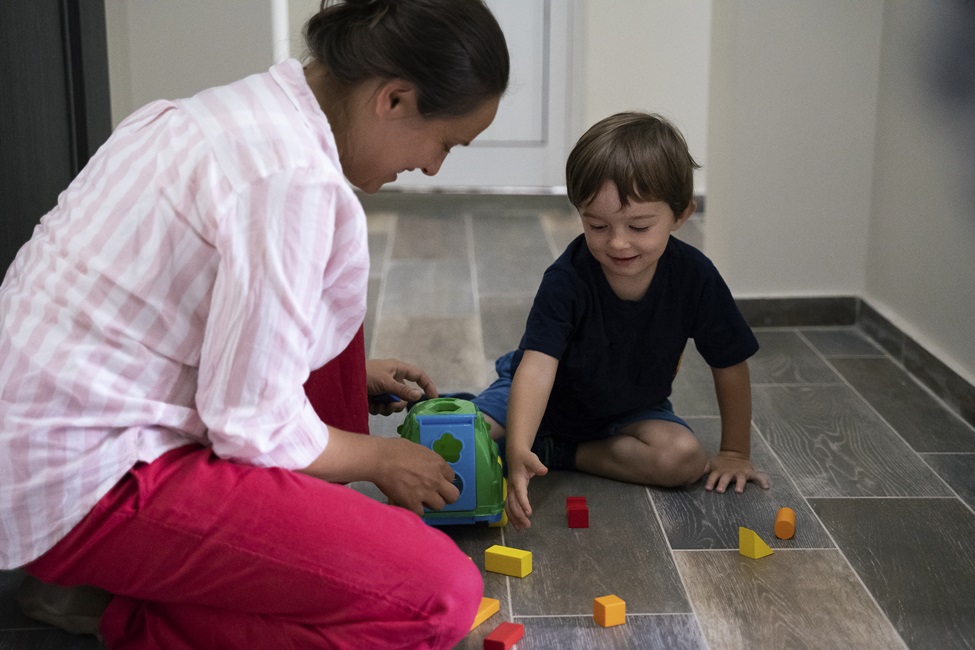Immigrant Bilingual Latina Mothers Have Dual-language Personalities

Researchers examined the quantity of maternal speech, how mothers elicited conversation in their children, child conversational participation, and the ratio of maternal-to-child utterances. They also tested whether heritage culture would be a source of any observed differences.
Children who hear a language other than English at home currently make up more than 25 percent of the school-aged population in the United States. A large majority of those children hear Spanish because that is the native language of their parents. When their parents came to the U.S., they brought not only their language, but also their culture with them.
Cultures vary in the way parents interact with their children. Thus, children of immigrant parents may experience different cultural practices regarding parent-child conversation than children of U.S. born parents, and these cultural practices shape the skills and behaviors they bring with them when they enter school.
To gain a better understanding of second-generation immigrants in the U.S., specifically South Florida, Florida Atlantic University researchers explored how culture shapes language use with children. They compared “mom talk” during toy play with foreign-born Spanish monolingual Latina mothers, foreign-born Spanish-English bilingual Latina mothers, and U.S.-born English monolingual European American mothers and their U.S.-born, 2.5-year-old children.
For the study, researchers recorded the mothers in conversation with their children – bilingual Latina mothers were recorded twice, once interacting in Spanish and once in English – and then examined the quantity of maternal speech, how mothers elicited conversation in their children, child conversational participation, and the ratio of maternal-to-child utterances.
They also tested whether heritage culture would be a source of any observed differences in how the bilingual mothers interacted with their children in English compared to Spanish. Do the bilingual mothers have two different cultures that they switch between, making them they more Latin-like when speaking Spanish and more European American-like when speaking English?
Results, published in the Journal of Cross-Cultural Psychology , showed that they do. Bilingual immigrants retain their cultural practices in play conversations with their children – particularly when speaking in their heritage language. Bilinguals switch cultural practices when they switch languages, and these effects of culture and cultural frame switching, as it is referred to, extend to language use with young children.
“Our findings show that it really is the heritage culture that changes the behavior and it’s not about being in Latin America or being in the U.S.,” said Erika Hoff, Ph.D., senior author and a professor, Department of Psychology, FAU Charles E. Schmidt College of Science. “It is the same mother and the same child, however, they are different depending on whether they ‘turn on’ the Spanish switch or whether they ‘turn on’ the English switch. Actually, it’s more like a dimmer switch on cultural practices, because the degree to which mothers are Latin-like or European American-like can vary. Also, we found that immigrant mothers are increasingly American-like in their talk with their children as a function of how long they have lived in the U.S., even when they’re speaking Spanish.”
The nature of the difference between Latin-like and European American-like style is in the balance of mother talk to child talk. The monolingual Spanish-speaking Latina mothers talked more and asked fewer questions of their children, and their children talked less compared with monolingual English-speaking European American mothers and their children. Spanish and English conversations between the bilingual mothers and their children similarly differed in the ratio of adult to child speech. This suggests that children of Latina immigrant mothers in the U.S. are socialized to talk less.
“In Latin America, adults do not elicit conversation from small children to the same extent that middle-class European American mothers do,” said Hoff. “In fact, that is not the culture in many places. So, when you ask Latin American mothers to sit down with their 2.5-year-old children and play with toys or read a book, you get more ‘mom’ talk and less child talk. Conversely, with European American mothers, you get less mom talk and more child talk.”
Children in Latino families are expected to show respect for others by conducting themselves in a way that is not disruptive to the group and by listening to adults. And compared with children of European American mothers, they do. In contrast, children in European American families are encouraged to express their individuality.
“Children of Latin American mothers are socialized to use language a little bit differently than children of European American mothers. They’re socialized to listen more and talk less, even in their English interaction,” said Hoff. “I would advise teachers and those who evaluate children of immigrant families not to make the same assumptions they would for children of U.S.-born monolingual English-speaking families. They are not going to be as talkative, and it is not because they know less or are less able. It is because that is what they have been taught.”
Study co-author is Katherine F. Shanks, Ph.D., a former graduate student in the FAU Department of Psychology.
The study was supported by a grant from the Eunice Kennedy Shriver National Institute of Child Health and Human Development of the National Institutes of Health awarded to Hoff.
-FAU-
Tags: faculty and staff | science | research | broward